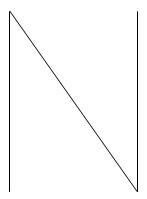1.
Definition and general characteristics of the word-group.
There
are a lot of definitions concerning the word-group. The most adequate
one seems to be the following: the word-group is a combination of at
least two notional words which do not constitute the sentence but are
syntactically connected. According to some other scholars (the
majority of Western scholars and professors B.Ilyish and V.Burlakova
– in Russia), a combination of a notional word with a function word
(on
the table)
may be treated as a word-group as well. The problem is disputable as
the role of function words is to show some abstract relations and
they are devoid of nominative power. On the other hand, such
combinations are syntactically bound and they should belong
somewhere.
General
characteristics of the word-group are:
1)
As a naming unit it differs from a compound word because the number
of constituents in a word-group corresponds to the number of
different denotates:
a
black bird – чорний
птах
(2), a blackbird – дрізд
(1);
a loud speaker (2), a loudspeaker (1).
2)
Each component of the word-group can undergo grammatical changes
without destroying the identity of the whole unit: to
see a house — to see houses.
3)
A word-group is a dependent syntactic unit, it is not a communicative
unit and has no intonation of its own.
2.
Classification of word-groups.
Word-groups
can be classified on the basis of several principles:
-
According
to the type of syntagmatic relations: coordinate
(you
and
me),
subordinate
(to
see a house, a nice dress),
predicative
(him
coming, for him to come), -
According
to the structure: simple
(all elements are obligatory), expanded
(to
read and translate the text
– expanded elements are equal in rank), extended
(a word takes a dependent element and this dependent element becomes
the head for another word: a
beautiful
flower
– a very beautiful flower).
3.
Subordinate word-groups.
Subordinate
word-groups are based on the relations of dependence between the
constituents. This presupposes the existence of a governing
Element
which is called the
head and
the dependent element which is called the
adjunct
(in noun-phrases) or the
complement
(in verb-phrases).
According
to the nature of their heads, subordinate word-groups fall into
noun-phrases
(NP) – a
cup of tea,
verb-phrases
(VP) – to
run fast,
to
see
a house,
adjective
phrases
(AP) – good
for you,
adverbial
phrases
(DP) – so
quickly,
pronoun
phrases
(IP) – something
strange, nothing to
do.
The
formation of the subordinate word-group depends on the valency of its
constituents. Valency
is
a potential ability of words to combine. Actual realization of
valency in speech is called combinability.
4.
The noun-phrase (NP).
Noun
word-groups are widely spread in English. This may be explained by a
potential ability of the noun to go into combinations with
practically all parts of speech. The NP consists of a noun-head and
an adjunct or adjuncts with relations of modification between them.
Three
types of modification are distinguished here:
-
Premodification
that comprises all the units placed before the head:
two
smart hard-working
students. Adjuncts
used in pre-head position are called pre-posed
adjuncts. -
Postmodification
that comprises all the units all the units placed after the head:
students
from
Boston.
Adjuncts used in post-head position are called post-posed
adjuncts. -
Mixed
modification
that comprises all the units in both pre-head and post-head
position: two
smart hard-working
students from
Boston.
|
Pre-posed |
|
Post-posed |
|
Pronoun |
Adj. |
|
|
Adj. |
Ven |
|
|
N2 |
Ving |
|
|
N`s |
prep.N2 |
|
|
Ven |
prepVing |
|
|
Ving |
D |
|
|
Num |
Num |
|
|
D |
wh-clause, |
X
5.
Noun-phrases with pre-posed adjuncts.
In
noun-phrases with pre-posed modifiers we generally find adjectives,
pronouns, numerals, participles, gerunds, nouns, nouns in the
genitive case (see the table). According to their position all
pre-posed adjuncts may be divided into pre-adjectivals
and adjectiavals.
The position of adjectivals is usually right before the noun-head.
Pre-adjectivals occupy the position before adjectivals. They fall
into two groups: a) lim
iters (to
this
group belong mostly particles): just,
only, even, etc.
and b) determiners
(articles, possessive pronouns, quantifiers – the
first, the last).
Premodification
of nouns by nouns (N+N) is one of the most striking features about
the grammatical organization of English. It is one of devices to make
our speech both laconic and expressive at the same time. Noun-adjunct
groups result from different kinds of transformational shifts. NPs
with pre-posed adjuncts can signal a striking variety of meanings:
world
peace – peace all over the world
silver box – a box made of
silver
table lamp – lamp for tables
table legs – the legs
of the table
river sand – sand from the river
school child
– a child who goes to school
The
grammatical relations observed in NPs with pre-posed adjuncts may
convey the following meanings:
-
subject-predicate
relations: weather
change; -
object
relations: health
service, women hater; -
adverbial
relations:
a)
of time: morning
star,
b) place: world
peace, country house,
c) comparison: button
eyes,
d)
purpose: tooth
brush.
It
is important to remember that the noun-adjunct is usually marked by a
stronger stress than the head.
Of
special interest is a kind of ‘grammatical idiom’ where the
modifier is reinterpreted into the head: a
devil of a man, an angel of a girl.
6.
Noun-phrases with post-posed adjuncts.
NPs
with post-posed may be classified according to the way of connection
into prepositionless
and prepositional.
The basic prepositionless NPs with post-posed adjuncts are: Nadj. –
tea
strong,
NVen – the
shape unknown,
NVing – the
girl smiling,
ND – the
man
downstairs,
NVinf – a
book to read,
NNum – room
ten.
The
pattern of basic prepositional NPs is N1 prep. N2. The most common
preposition here is ‘of’ – a
cup of tea,
a
man of courage.
It may have quite different meanings: qualitative
—
a
woman of sense,
predicative
– the
pleasure of the company,
objective
– the
reading of the newspaper,
partitive
–
the
roof of the house.
Соседние файлы в предмете [НЕСОРТИРОВАННОЕ]
- #
- #
- #
- #
- #
- #
- #
- #
- #
- #
- #
Free word-groups. Definition. Classification.
A word-group is the largest two-facet lexical unit comprising more than one word but expressing one global concept.
The lexical meaning of the word groups is the combined lexical meaning of the component words. The meaning of the word groups is motivated by the meanings of the component members and is supported by the structural pattern. But it’s not a mere sum total of all these meanings! Polysemantic words are used in word groups only in 1 of their meanings. These meanings of the component words in such word groups are mutually interdependent and inseparable (blind man – «a human being unable to see», blind type – «the copy isn’t readable).
Word groups possess not only the lexical meaning, but also the meaning conveyed mainly by the pattern of arrangement of their constituents. The structural pattern of word groups is the carrier of a certain semantic component not necessarily dependent on the actual lexical meaning of its members (school grammar – «grammar which is taught in school», grammar school – «a type of school»). We have to distinguish between the structural meaning of a given type of word groups as such and the lexical meaning of its constituents.
It is often argued that the meaning of word groups is also dependent on some extra-linguistic factors – on the situation in which word groups are habitually used by native speakers.
Words put together to form lexical units make phrases or word-groups. One must recall that lexicology deals with words, word-forming morphemes and word-groups.
The degree of structural and semantic cohesion of word-groups may vary. Some word-groups, e.g. at least, point of view, by means, to take place, etc. seem to be functionally and semantically inseparable. They are usually described as set phrases, word-equivalents or phraseological units and are studied by the branch of lexicology which is known as phraseology. In other word-groups such as to take lessons, kind to people, a week ago, the component-members seem to possess greater semantic and structural independence. Word-groups of this type are defined as free word-groups or phrases and are studied in syntax.
Word-groups are classified according to their syntactical pattern into predicative and non-predicative groups. Such word-groups as he went, Bob walks that have a syntactic structure similar to that of a sentence are termed as predicative, all others are non-predicative ones.
Non-predicative word-groups are divided into subordinative and coordinative depending on the type of syntactic relations between the components. E.g., a red flower, a man of freedom are subordinative non-predicative word-groups, red and freedom being dependent words, while day and night, do and die are coordinative non-predicative word-groups.
The lexical meaning of a word-group may be defined as the combined lexical meaning of the component members. But it should be pointed out, however, that the term «combined lexical meaning» does not imply that the meaning of the word-group is always a simple additive result of all the lexical meanings of the component words. As a rule, the meanings of the component words are mutually dependent and the meaning of the word-group naturally predominates over the lexical meaning of the components. The interdependence is well seen in word-groups made up of polysemantic words. E.g., in the phrases the blind man, the blind type the word blind has different meanings – unable to see and vague.
So we see that polysemantic words are used in word-groups only in one of their meanings.
The term motivation is used to denote the relationship existing between the phonemic or morphemic composition and structural pattern of the word on the one hand and its meaning on the other.
Лекции по лексикологии — файл Word-groups.doc
Доступные файлы (26):
| Affixation and conversion.doc | 30kb. | 27.01.2009 21:35 |  скачать скачать |
| Assimilation of borrowings.doc | 64kb. | 26.02.2009 13:30 |  скачать скачать |
| Basic notions. Categorization naming lexicolization motivation.doc | 69kb. | 26.02.2009 13:30 |  скачать скачать |
| Compounding.doc | 72kb. | 26.02.2009 13:30 |  скачать скачать |
| Derivative structure.doc | 70kb. | 26.02.2009 13:30 |  скачать скачать |
| Dictionaries.doc | 67kb. | 26.02.2009 13:30 |  скачать скачать |
| Etymological doublets and hybrids.doc | 64kb. | 26.02.2009 13:30 |  скачать скачать |
| Etymological doublets.doc | 25kb. | 27.01.2009 21:35 |  скачать скачать |
| Etymological structure of English vocabulary.doc | 63kb. | 26.02.2009 13:30 |  скачать скачать |
| Free word-groups vs PU.doc | 63kb. | 26.02.2009 13:30 |  скачать скачать |
| L. as a science.doc | 77kb. | 26.02.2009 13:30 |  скачать скачать |
| LU.doc | 64kb. | 26.02.2009 13:30 |  скачать скачать |
| Meaning.doc | 66kb. | 26.02.2009 13:30 |  скачать скачать |
| Morphemic structure.doc | 70kb. | 26.02.2009 13:30 |  скачать скачать |
| Polysemy vs homonymy.doc | 64kb. | 26.02.2009 13:30 |  скачать скачать |
| Productivity and activity.doc | 67kb. | 26.02.2009 13:30 |  скачать скачать |
| Synonyms vs antonyms.doc | 66kb. | 26.02.2009 13:30 |  скачать скачать |
| Syntagmatic vs paradigmatic relations.doc | 68kb. | 26.02.2009 13:30 |  скачать скачать |
| Types of borrowings.doc | 88kb. | 26.02.2009 13:30 |  скачать скачать |
| Valence.doc | 64kb. | 26.02.2009 13:30 |  скачать скачать |
| Ways of enrichment.doc | 64kb. | 26.02.2009 13:30 |  скачать скачать |
| Word-formation.doc | 66kb. | 26.02.2009 13:30 |  скачать скачать |
| Word-groups.doc | 67kb. | 26.02.2009 13:30 |  скачать скачать |
| Words vs morphemes.doc | 64kb. | 26.02.2009 13:30 |  скачать скачать |
| Вопросы по лексикологии.doc | 68kb. | 26.02.2009 13:31 |  скачать скачать |
| Лексикология.doc | 178kb. | 26.02.2009 13:31 |  скачать скачать |
Word-groups.doc
The structure and meaning.
1) The structure is shown be a syntactic formula (синтаксическая структура словосочетания). It shows the structure of word-groups by the order of the arrangement of their components indicating them as parts of speech (V+N = te release a prisoner, to run a factory).
2) By using syntactic patterns (синтаксическая модель). They describe the word groups in relation to the head word (to release, to run).
The word-groups have lexical and structural meaning.
Lexical meaning is defined as the combined lexical meaning of the component words. Idiomatic meaning — the total change of the initial combined meaning (to catch smb red-handed)
Structural meaning is conveyed by the pattern of arrangement of its constituents (school grammar — grammar school).
— Predicative — have syntactic structure similar to that of a sentence (the horse has run away)
— Non-predicative: subordinate and coordinate.
Subordinate word-groups — consist of a head-word and words subordinate to it (to release a prisoner). In coordinate word-groups — all elements are equal (brother and sister).
If the word-group is used in the same function as one of its members — endocentric. Exocentric — are those that are used differently from either of its members.
— Lexically motivated — the meaning of a word-group is equal to the combined meaning of its components.
— Lexically non-motivated — the word-groups whose meaning is different from the combined meaning of its components (Hobson’s choice — нет выбора; the horse has run away — motivated, the horse has bolted — non-motivated).
Types of Meaning of Word-Groups
The meaning of word-groups can be divided into: 1) lexical and 2) structural (grammatical) components.
1. The lexical meaning of the word-group may be defined as the combined lexical meaning of the component words. Thus, the lexical meaning of the word-group red flower may be described denotationally as the combined meaning of the words red and flower. However, the term “combined lexical meaning” is not to imply that the meaning of the word-group is a mere additive result of all the lexical meanings of the component members. The lexical meaning of the word-group predominates over the lexical meanings of its constituents.
2. The structural meaningof the word-group is the meaning conveyed mainly by the pattern of arrangement of its constituents. For example, such word-groups as school grammar (школьная грамматика) and grammar school (грамматическая школа) are semantically different because of the difference in the pattern of arrangement of the component words.
Thus, the meaning of the word-group is derived from the combined lexical meanings of its constituents and is inseparable from the meaning of the pattern of their arrangement.
Motivation in Word-Groups
Semantically all word-groups can be classified into motivated and non-motivated.
A word-group is lexically motivated if the combined lexical meaning of the group is deducible from the meanings of its components, e.g. red flower, heavy weight, teach a lesson.
If the combined lexical meaning of a word-group is not deducible from the lexical meaning of its constituent components, such a word-group is lexically non-motivated, e.g. red tape (“official bureaucratic methods”), take place (“occur”).
The degree of motivation can be different. Between the extremes of complete motivation and lack of motivation there are innumerable intermediate cases. For example, the degree of lexical motivation in the nominal group black market is higher than in black death, but lower than in black dress, though none of the groups can be considered completely non-motivated.
Completely non-motivated or partially motivated word-groups are described as phraseological units or idioms.
Free Word-Groups Versus Phraseological Units Versus Words
A phraseological unit can be defined as a reproduced and idiomatic (non-motivated) or partially motivated unit built up according to the model of free word-groups (or sentences) and semantically and syntactically brought into correlation with words. Hence, there is a need for criteria exposing the degree of similarity/difference between phraseological units and free word-groups, phraseological units and words.
Structural Criterion
The structural criterion brings forth pronounced features which on the one hand state a certain structural similarity between phraseological units and free word-combinations at the same time opposing them to single words (a), and on the other hand specify their structural distinctions (b).
(a) A feature proper both to free phrases and phraseological units is the divisibility (раздельнооформленность) of their structure, i.e. they consist of separate structural elements. This fact stands them in opposition to words as structurally integral (цельнооформленные) units. The structural integrity of a word is defined by the presence of a common grammatical form for all constituent elements of this word. For example, the grammatical change in the word shipwreck implies that inflexions are added to both elements of the word simultaneously – ship-wreck-( ), ship-wreck-s, while in the word-group the wreck of a ship each element can change its grammatical form independently from the other – (the) wreck-( ) of the ship-s, (the) wreck-s of (the) ship-s. Like in word-groups, in phraseological units potentially any component may be changed grammatically, but these changes are rather few, limited and occasional and usually serve for a stylistic effect, e.g. Black Maria “a van used by police for bringing suspected criminals to the police station”: the Blackest Maria, Black Marias.
(b) The principle difference between phraseological units and free word-groups manifests itself in the structural invariability of the former. The structural invariability suggests no (or rather limited) substitutions of components. For example, to give somebody the cold shoulder means “to treat smb. coldly, to ignore smb”, but a warm shoulder or a cold elbow makes no sense. There are strict restrictions on the componental extension and grammatical changes of components of phraseological units. The use of the words big, great in a white elephant meaning “an expensive but useless thing” can change or even destroy the meaning of the phraseological unit. In a free word-group all these changes are possible.
Semantic Criterion
The semantic criterion is of great help in stating the semantic difference/similarity between free word-groups and phraseological units (a), and between phraseological units and words (b).
(a) The meaning in phraseological units is created by mutual interaction of elements and conveys a single concept. The actual meaning of a phraseological unit is figurative (transferred) and is opposed to the literal meaning of a word-combination from which it is derived. The transference of the initial word-group can be based on simile, metaphor, metonomy and synecdoche. The degree of transference varies and may affect either the whole unit or only one of its constituents, cf.: to skate on thin ice – “to take risks”; the small hours – “the early hours of the morning”. Besides, in the formation of the semantic structure of phraseological units a cultural components plays a special and very important role. It marks phraseological units as bearers of cultural information based on a unique experience of the nation. For example, the phraseological unit red tape originates in the old custom of Government officials and lawyers tying up (перевязывать) their papers with red tape.
In a free phrase the semantic correlative ties are fundamentally different. The meaning in a word-group is based on the combined meaning of the words constituting its structure. Each element in a word-combination has a much greater semantic independence and stands for a separate concept, e.g. to cut bread, to cut cheese, to eat bread. Every word in a free phrase can form additional syntactic ties with other words outside the expression retaining its individual meaning.
(b) The semantic unity, however, makes phraseological units similar to words. The semantic similarity between the two is proved by the fact that, for instance, kick the bucket whose meaning is understood as a whole and not related to the meaning of individual words can be replaced within context by the word to die, the phraseological unit in a brown study – by the word gloomy.
Syntactic Criterion
The syntactic criterion reveals the close ties between single words and phraseological units as well as free word-groups. Like words (as well as word-combinations) phraseological units may have different syntactic functions in the sentence, e.g. the subject (narrow escape, first night, baker’s dozen), the predicate (to have a good mind, to play Russian roulette), an attribute (high and mighty, as ugly as sin), an adverbial (in full swing, on second thoughts). In accordance with the function they perform in the sentence phraseological units can be classified into: substantive, verbal, adjectival, adverbial, interjectional.
Like free word-groups phraseological units can be divided into coordinative (e.g. free and easy, neck and crop) and subordinative (e.g. a big fish in a little pond, the villain of the piece).
Thus, the characteristic features of phraseological units are: ready-made reproduction, structural divisibility, morphological stability, permanence of lexical composition, semantic unity, syntactic fixity.
- Размер: 58 Кб
- Количество слайдов: 27
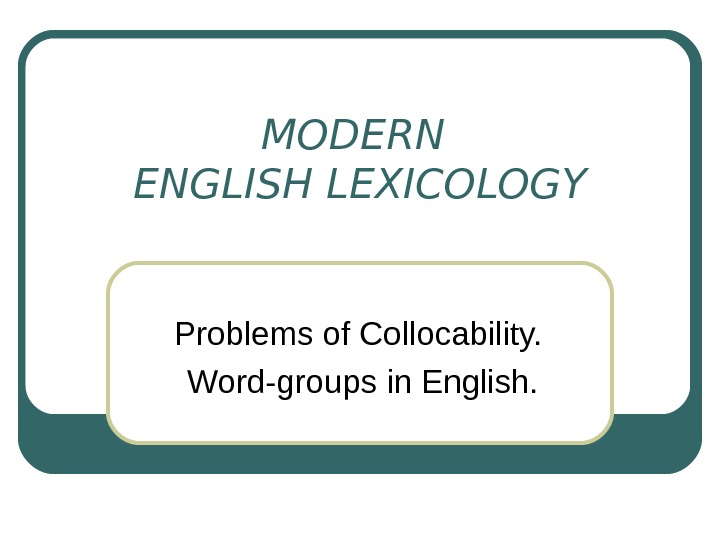
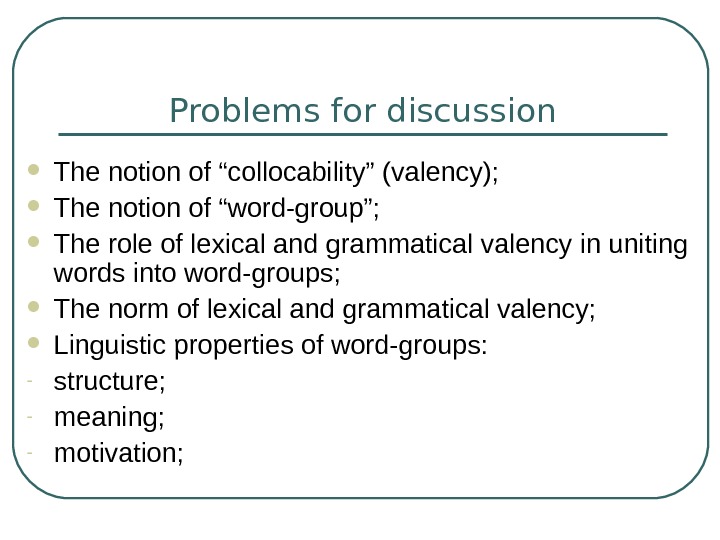
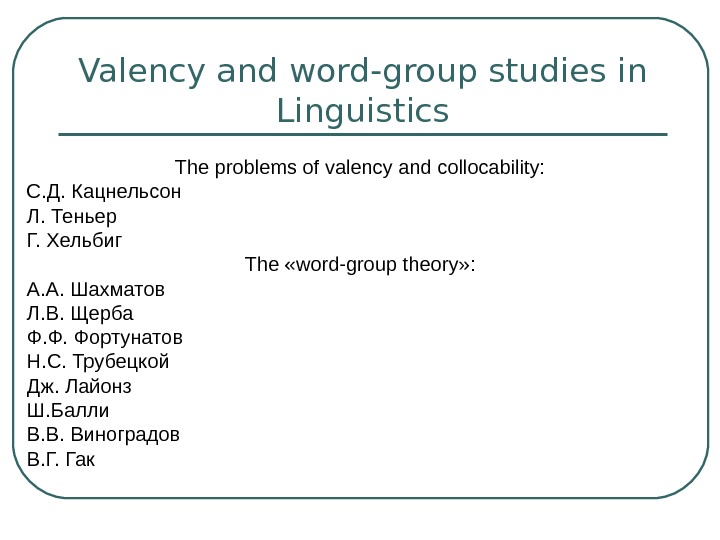
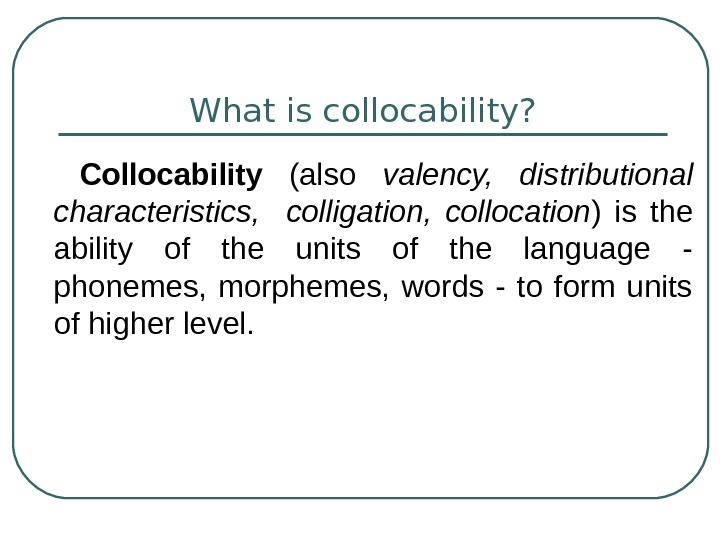
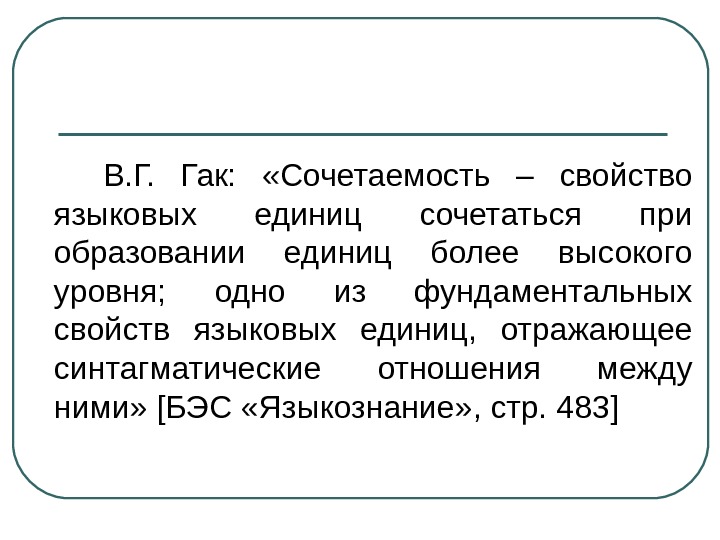

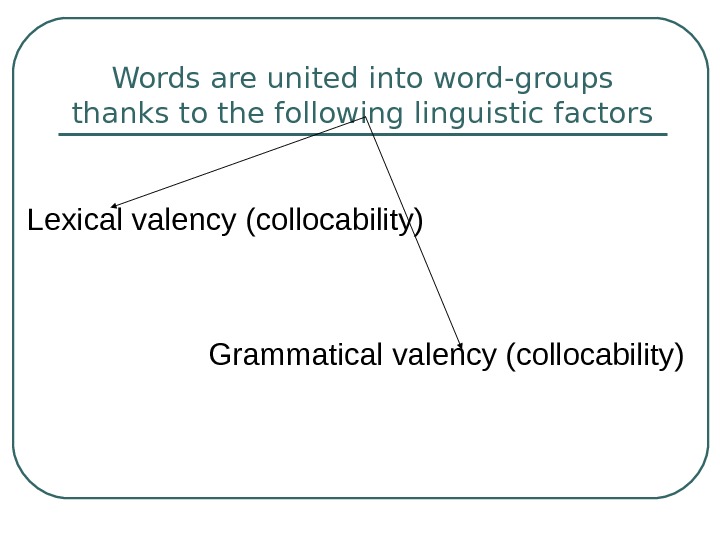
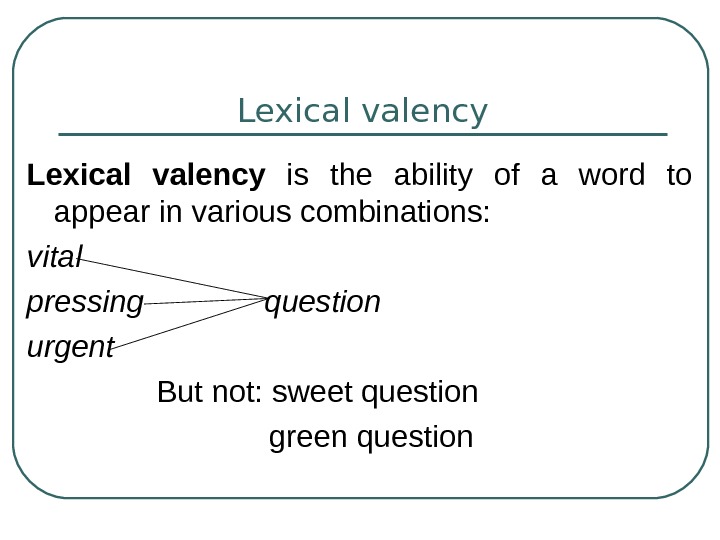
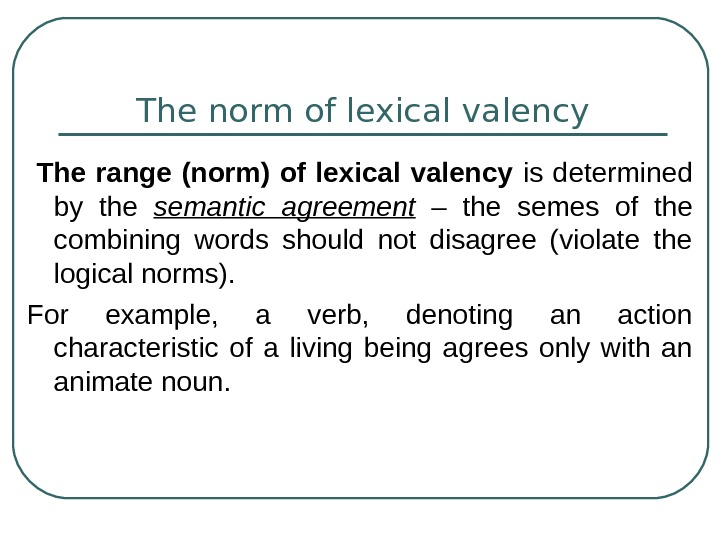
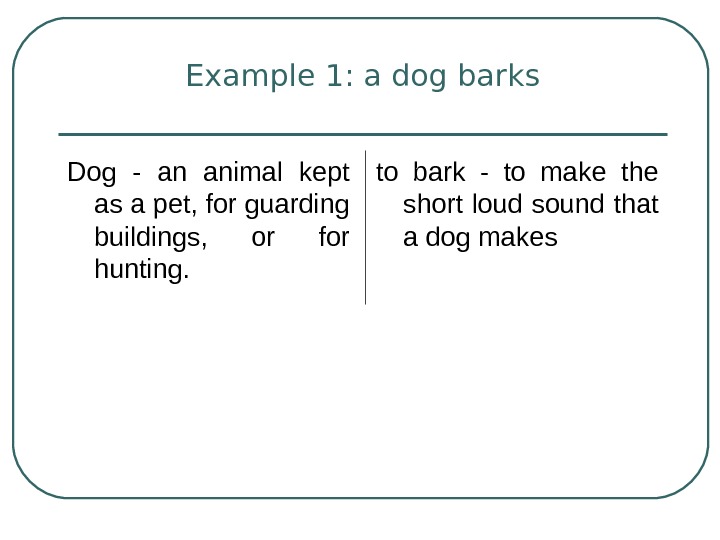
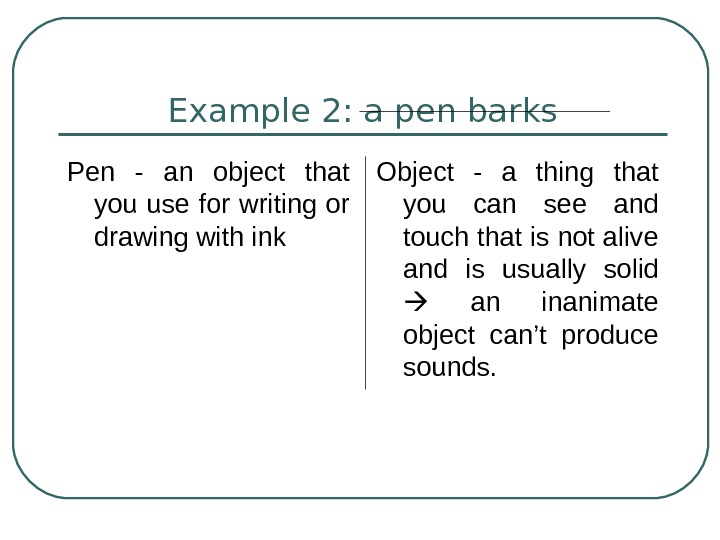
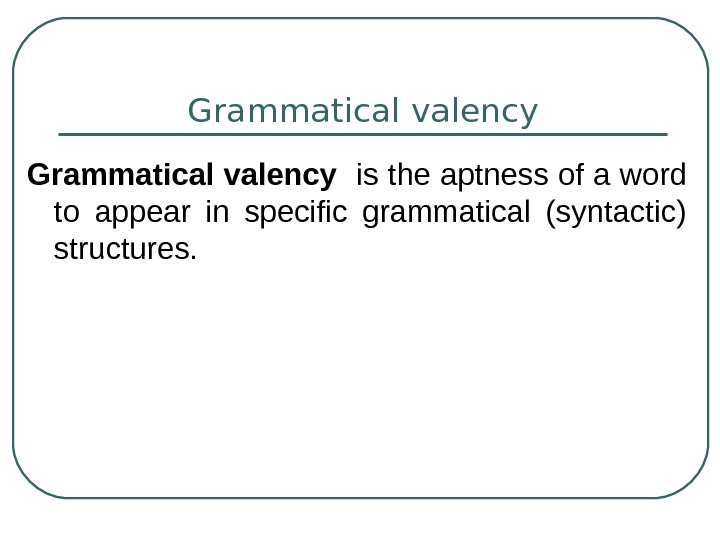
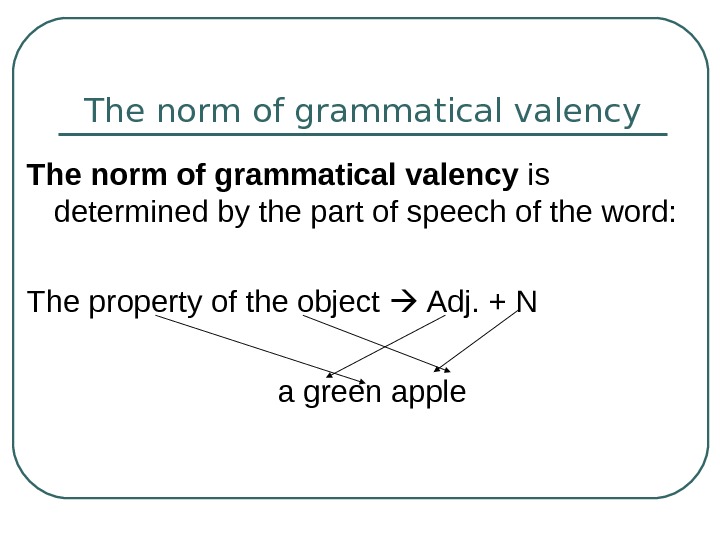
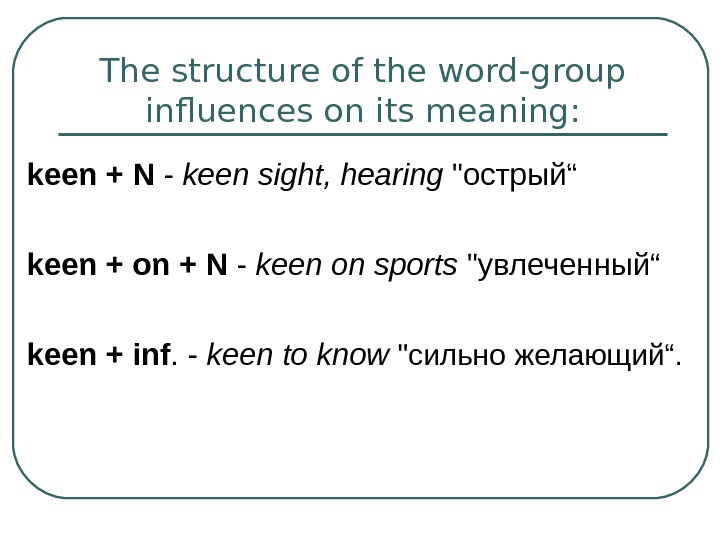
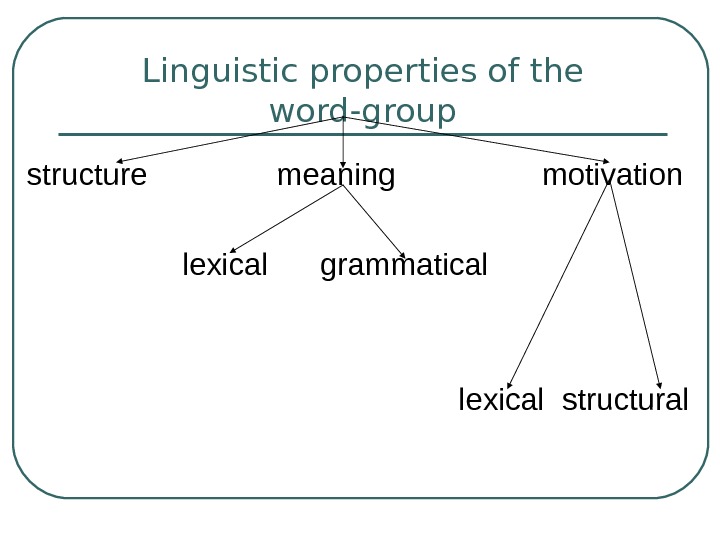
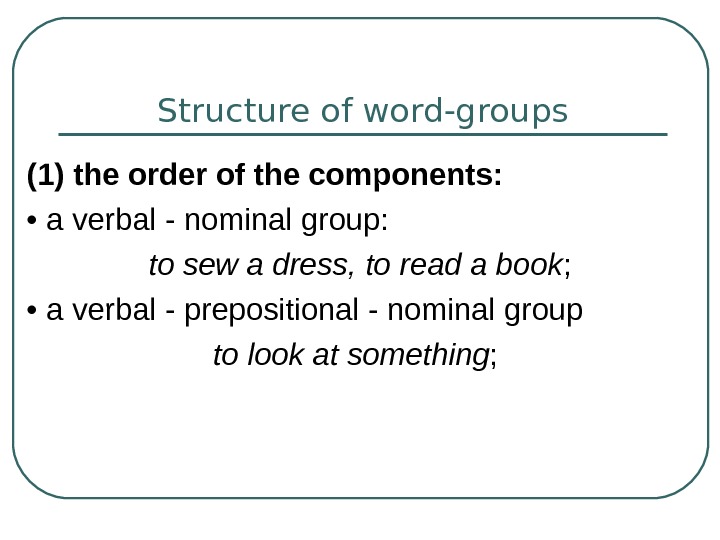
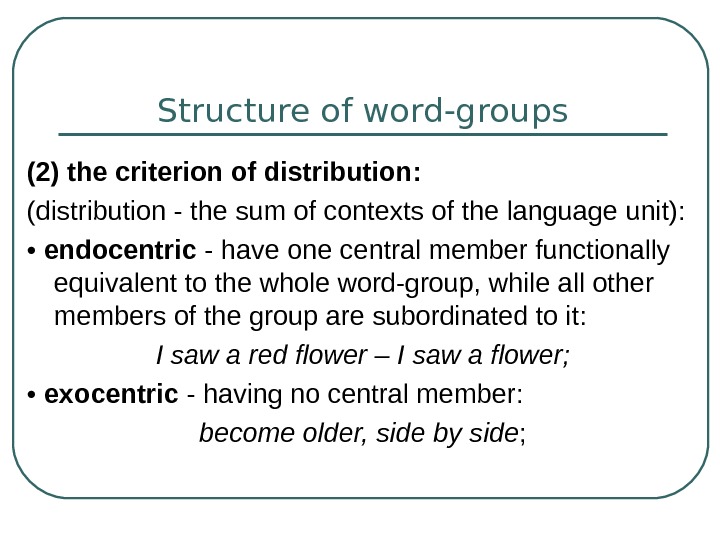
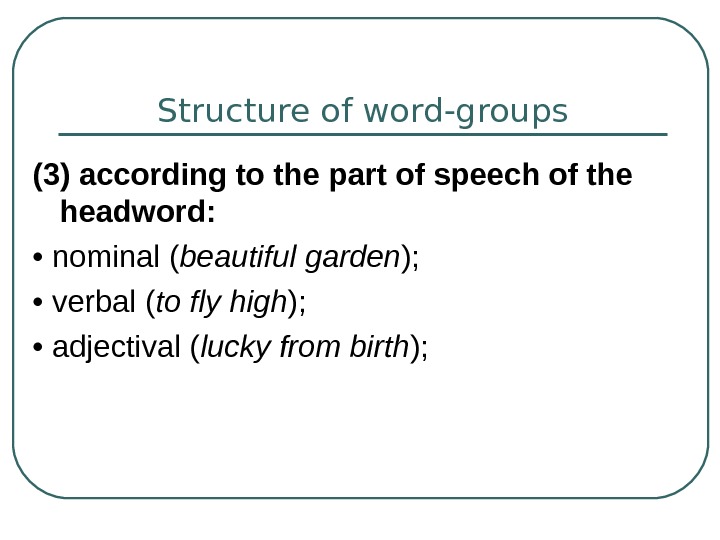
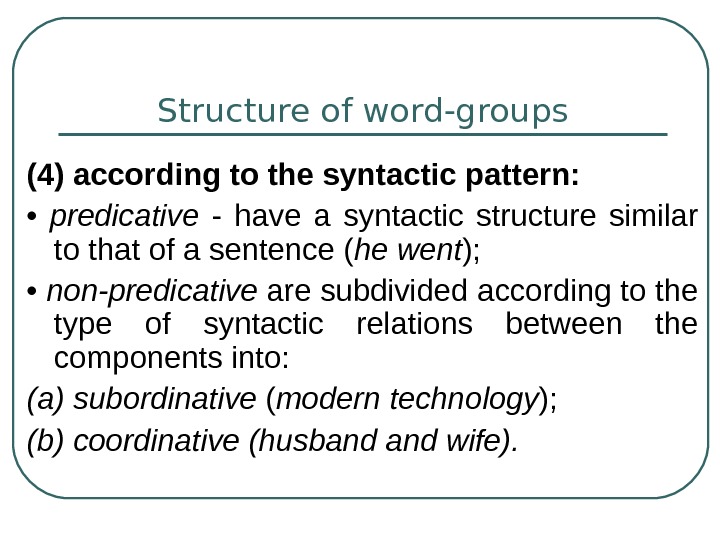

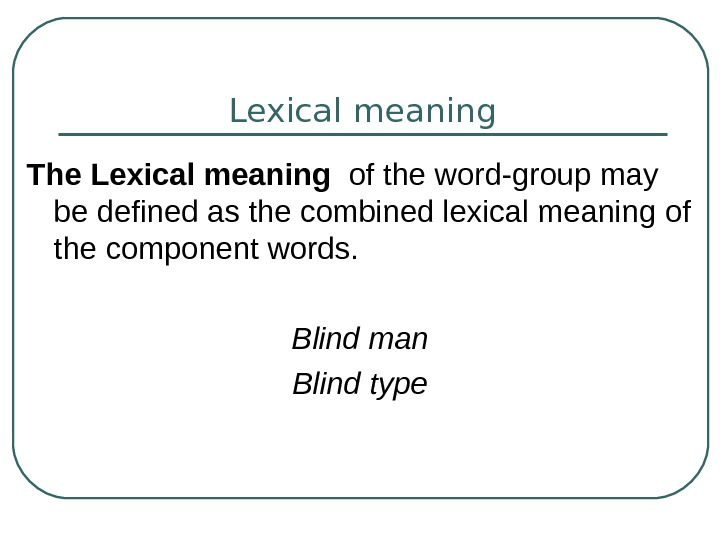
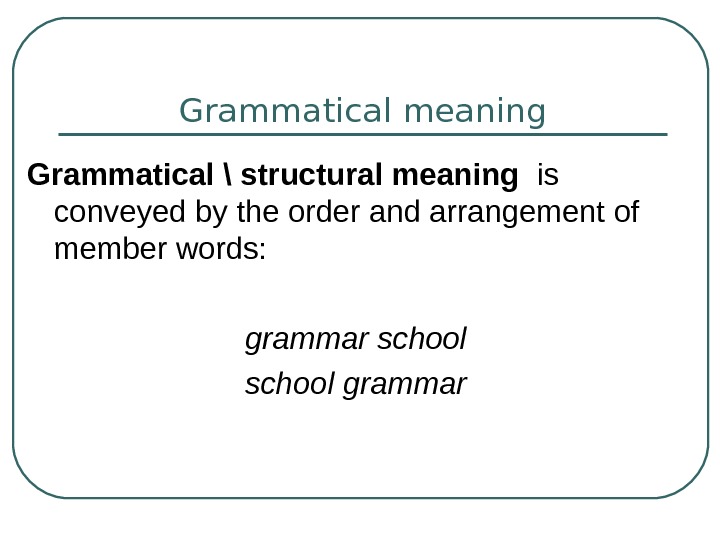
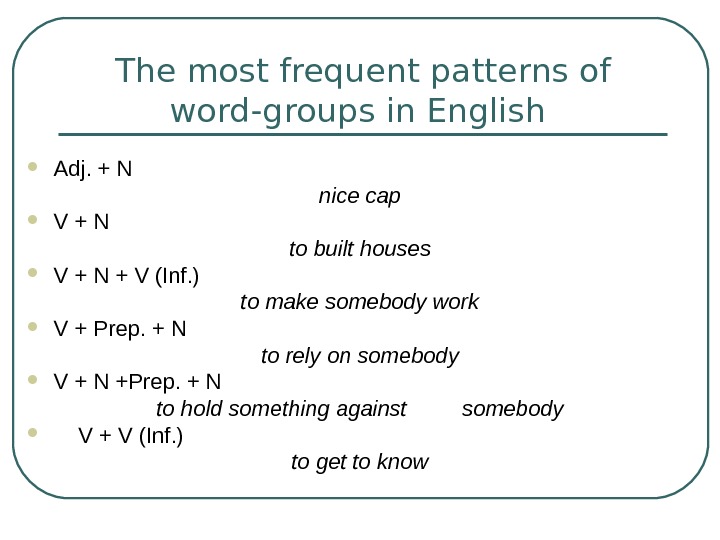
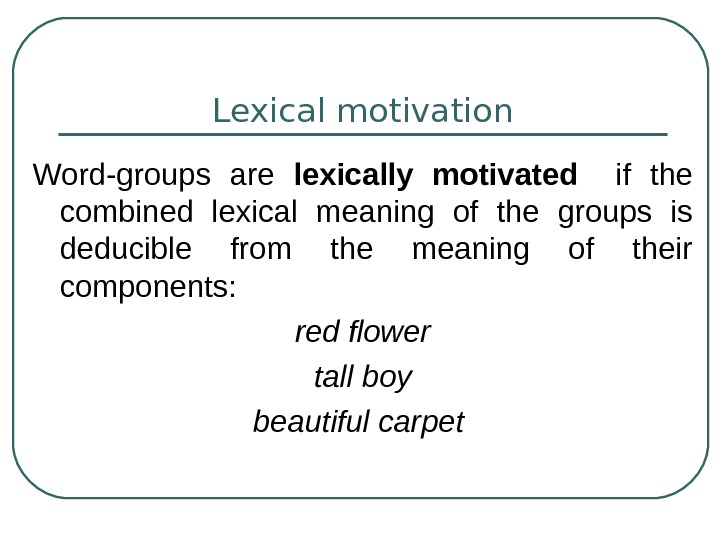
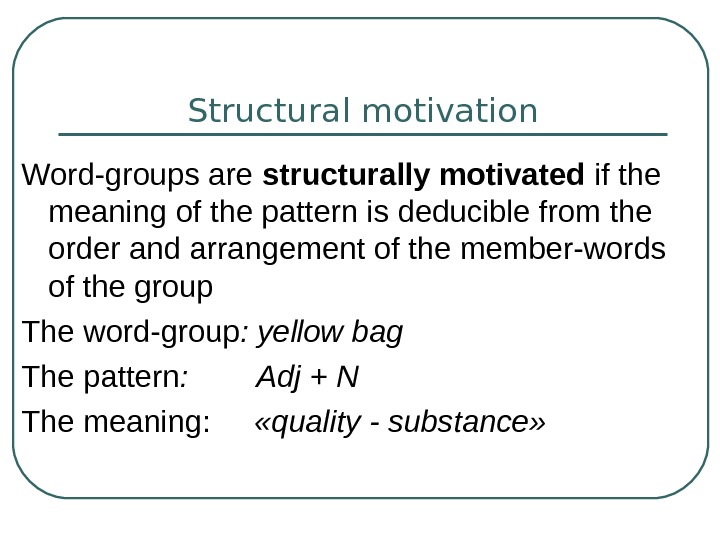
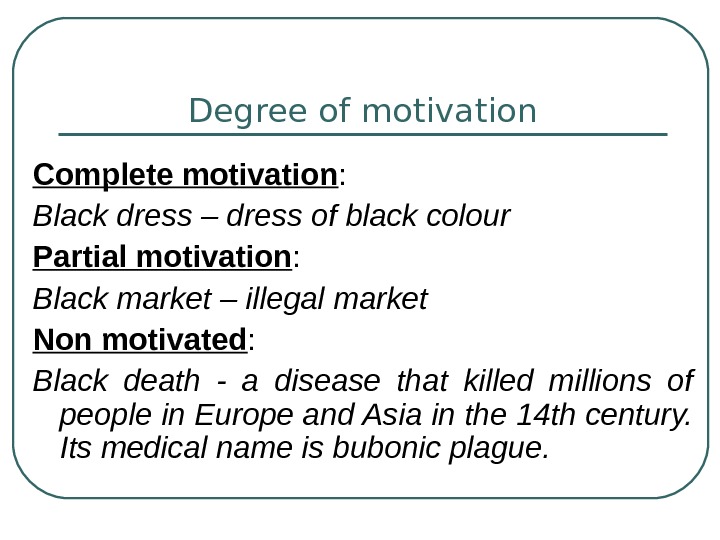
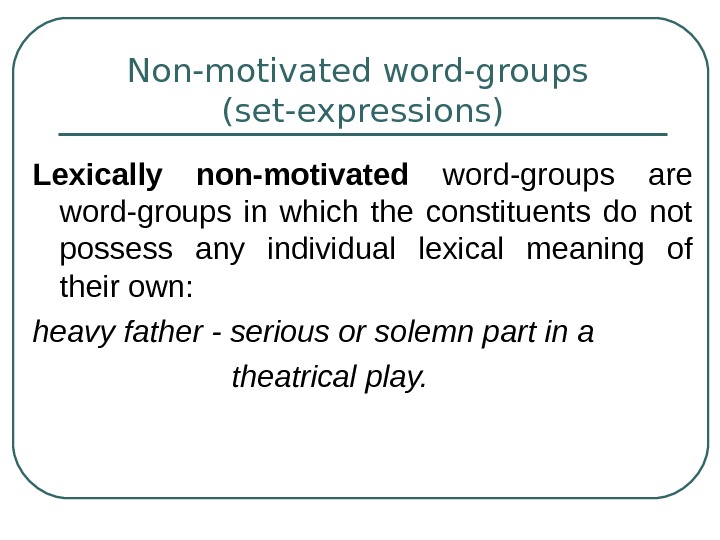
The following article is from The Great Soviet Encyclopedia (1979). It might be outdated or ideologically biased.
Word Group
the simplest nonpredicative (as contrasted to the sentence) unit of speech. The word group is formed on a syntactic pattern and based on a subordinating grammatical relationship between two or more content words. This relationship may be one of agreement, government, or subordination. The grammatically predominant word is the main element of the word group, and the grammatically subordinated word the dependent element.
A word group denotes a fragment of extralinguistic reality. The word group combines formally syntactic and semantically syntactic features. Such features reveal the compatibility of grammatical and lexical meanings with the structure of the object-logical relations that these meanings reflect.
Word groups may be free or phraseological. Free word groups are formed in accordance with regular and productive combinative principles; their meanings may be deduced from those of the component words.
REFERENCES
Vinogradov, V. V. “Voprosy izucheniia slovosochetanii.” Voprosy iazykoznaniia, 1954, no. 3.
Grammatika russkogo iazyka, part 1. Moscow, 1954.
Grammatika sovremennogo russkogo literaturnogo iazyka. Moscow, 1970.
Obshchee iazykoznanie, vol. 2. Moscow, 1972. Pages 270–99.
V. N. TELIIA
The Great Soviet Encyclopedia, 3rd Edition (1970-1979). © 2010 The Gale Group, Inc. All rights reserved.
Слайд 1
The Word-Group Theory
Lecture 4. Part 2

Слайд 2
Lecture outline
Syntactic relations.
The definition and general characteristics.
Classification of

word-groups.
Слайд 3
The syntactic notions
Syntactic relations: the syntagmatic (linear) relations

between the syntactic units.
1) Coordination and subordination (traditionally);
2) +
predication;
3) + accumulation (Burlakova et al.).
Barkhudarov: on the basis of
equality/inequality of the syntactic function of the whole group and its IC (immediate constituents)
Слайд 4
The syntactic relations
Coordination (independence):
word group, sentence, text;

the syntactic function of the whole group coincides with
the syntactic function of every IC: pens and pencils were
purchased (pens were purchased, pencils were purchased);
symmetric and asymmetric (pens and pencils, ladies and gentlemen);
copulative (you and me), disjunctive (you or me), adversative (strict but just), causative-consecutive (He didn’t come, because…).
Слайд 5
The syntactic relations
Subordination (dependence, difference linguistic rank):
word-group and

sentence;
the syntactic function of the whole coincides with the
function of one of ICs: A tall boy came in
(A boy came in, * Tall came in);
adverbial (to run slowly), objective (to help a friend); attributive (a new house) (Burlakova, the functions in a sentences);
the head and the adjunct.
Слайд 6
Syntactic relations
Predication (interdependence):
the syntactic function of the whole

group is different from the syntactic function of every
IC: The boy reads well (* the boy well, *
reads well);
primary (the subject and the predicate): men worked;
secondary (non-finite forms of the verb and nominal elements): his reading, for me to know, the boy running, I saw him run;
Burlakova: the term is not very good (in not consistent with coordination and subordination; interdependence – the relation b/w the IC).
Слайд 7
Syntactic relations
Accumulative
The relations b/w the constituents can be

identified only with regard to the word which is
not the part of the word combination: (write) his friend
a letter; these important (decisions);
the positions of the components are fixed (*important these);
and cannot be used (*these and important; not coordinate).
Слайд 8
The word-group. The definition.
the basic unit of syntax

(as well as the sentence);
2 components minimum;
grammatical structure.
No generally
accepted definition; negative approach (sth the word-group is not or
does not have);
Non-communicative (vs. the sentence).
Слайд 9
The views on word-groups
Broad (every syntactically organized group,

the relations do not matter);
Narrow (two notional words).
General characteristics:
As
a naming unit it differs from a compound word: two
constituents = two denotates (a blackbird, a black bird);
A dependent syntactic unit; non-communicative, no intonation.
Слайд 10
The broad view: syntagmatic groupings
(by Blokh)
Notional words

(notional phrases): denote complex phenomena and their properties in
their interconnection (a caring mother);
Notional word + functional word (formative
combinations): equivalent to separate words in terms of their nominative function, can be expanded (in a box = in an old box);
Functional words: used as connectors or specifiers of notional elements of various status: up to, must be able.
Burlakova supports the broad view.
Слайд 11
The notional phrases (classification)
Equipotent (words are related on

equal rank);
Dominational (words are syntactically unequal).
Equipotent syndetic and asyndetic
(prose and poetry vs. dark, gloomy);
Equipotent coordinative (quick and careless)
and cumulative (agreed, but reluctantly; quick – and careless): equal formally, not in terms of domination.
Слайд 12
Dominational connection (Blokh)
The principal (dominating) – kernel, kernel

element, head word – and the subordinate constituents (adjunct,
adjunct-word, expansion).
Dominational consecutive (a careful observer);
Domination cumulative (an observer, seemingly
careful).
Слайд 13
Dominational connection (Blokh)
Dominational bilateral (reciprocal, two-way): predicative (complete

and incomplete) – the train arrived, the arrival of
the train, the pupil understanding his mistakes.
Dominational mono-lateral (completive): the
syntactic status of the whole element is determined by the nature of the head-word.
Слайд 14
Dominational connection (Blokh)
Dominational completive connection: objective and qualifying.
Objective:

direct non-prepositional (saw me), indirect non-prepositional (show me), indirect
prepositional (sympathised with the child).
Qualifying: attributive (the woman of strong
character; a beautiful ring); adverbial primary (verb+ adverbial modifier = receive with surprise); adverbial secondary (non-verbal kernel + adverbial modifier+ strikingly alike).
Слайд 15
The narrow view (Barkhudarov)
Word-group (phrase) is a group

of syntactically related notional words, which is the component
of a sentence, but does not constitute a sentence on
its own.
According to syntactic relations: subordinate (ready to go, politically active, cold water), co-ordinate (pens and pencils, strict but just), predicative (for you to go).
According to the number of types of relations expresses: elementary (three black dogs – subordination); compound (red and blue pencils – coordination and subordination).
Слайд 16
The subordinate phrase
Syntactically unequal;
The head and the adjunct.
Types:
The

word class to which the head belongs: noun phrases
(wonderful weather), verb phrases (run fast), adverb phrases (extremely quickly),
pronoun phrases (nothing interesting).
Слайд 17
The subordinate phrase: types
ICs represented with a word

or a word phrase:
simple (cold water);
with the
expanded head (saw him there, three black dogs);
with the
expanded adjunct (politically active youth);
with the expanded head and adjunct (the reception of the delegation by the President of the republic).
Слайд 18
The subordinate phrase: types
ICs separated / non-separated from

each other:
Continuous: nicely dressed;
Discontinuous: Slowly, Mr Johnson got
out of the chair; Of the threat she said nothing.
Слайд 19
Noun Phrases
The place of the adjunct:
Noun phrases with

pre-posed adjuncts: cold water, her shoulders, thirty-five minutes, slanting
stroke, quoted material, Paul’s room, consonant change.
Noun phrases with post-posed
adjuncts: the roof of the house, the people present, every creature alive, a man hard to please, desire to come, my life as an artist.
Слайд 20
Verb Phrases
According to the class of the verb:

Verb phrases with transitive head;
Verb phrases with the intransitive
head;
Verb phrases with the transitive or intransitive verb head.
The adjuncts
are divided accordingly:
Extensions (can be used with any head – transitive or intransitive);
Complements (the distribution is limited, with the verb of a particular class only).
Слайд 21
Verb phrases
Adjuncts (complements):
object complements (transitive head):
prepositional and non-prepositional

(wait for John, insist on doing vs. says not
to worry, read a book, turn the page).
!!! Prepositional complements
vs. extensions !!!
the preposition is determined by the verb vs. the preposition does not depend on the verb
He believes in God vs. He lives in Chicago.
!!! Non-preposition complements vs. extensions !!!
I came to speak with you vs. I wanted to speak with you
Extension can be substituted for ‘in order to’
Слайд 22
Verb phrases
Adjuncts (complements):
qualifying complements (intransitive head): rise slowly:

seemed quite the best plan, died an old man,
look severe, become proficient in.
Слайд 23
Verb phrases
According to the number and type of

adjuncts:
simple (see a boy, walk slowly);
verb phrases with two
extensions: He ran hastily downstairs;
verb phrases with an extension and
a compliments: I watched her closely;
verb phrases with two non-prepositional object complements: gave Tom a book;
verb phrases with a propositional and non-prepositional object complements: explained the whole affair to Mr Jones;
verb phrases with an object complement and a qualifying complement: consider it a privilege.
Слайд 24
Other types of phrases
Adjective phrases:
Politically active;

rich in possible modulations; larger units than the sentence;
loudest of all.
Adverb phrases:
Awfully quickly, rather sharply, high
in the air.
Pronoun phrases:
Some of the workers, nothing to do, something personal.
Слайд 25
Coordinate phrases
According to the means used to connect

the constituents:
Syndetic (with the conjunction): simple syndetic phrases (with
the continuous conjunction) – and, but, yet, or, rather, than,
as well as – and correlative syndetic phrases (with the discountinuous conjunction): both … and, either … or, neither … not, from … to.
Harsh and loud, precious nut remote, structural rather than historical.
Either a gerund or a participle, neither reading nor writing.
Слайд 26
Coordinate phrases
According to the means used to connect

the constituents:
Asyndetic: copulative (the co-ordinate conjunction can be used)
and appositive (conjunction cannot be used).
Hot, dusty, tired…
Bill, the dean’s
boy; you young people; the young man Edgar.
Слайд 27
Predicative phrases
The combinations of the subject and the

predicate are not included; The head is only NON-FINITE!
Infinitive
predicative phrases (for John to go, for her daughter to
look at her);
Gerund predicative phrases (John’s going, John being late);
Absolute predicative phrases: all things considered; (with) his voice trembling.
Other opinions: predicative phrases of two times: primary (the boy runs) and secondary (the boy’s running).
Слайд 28
Conclusion
The word-group is a combination of at least

two notional words (?) which do not constitute the
sentence but are syntactically connected.
The type of syntagmatic relations: coordinate,
subordinate, predicative.
The internal structure (simple, expanded – to read and translate the text, extended – a very beautiful flower).
Subordinate word-groups: the head and the adjunct; noun, verb, adjective, adverb, pronoun phrases.

